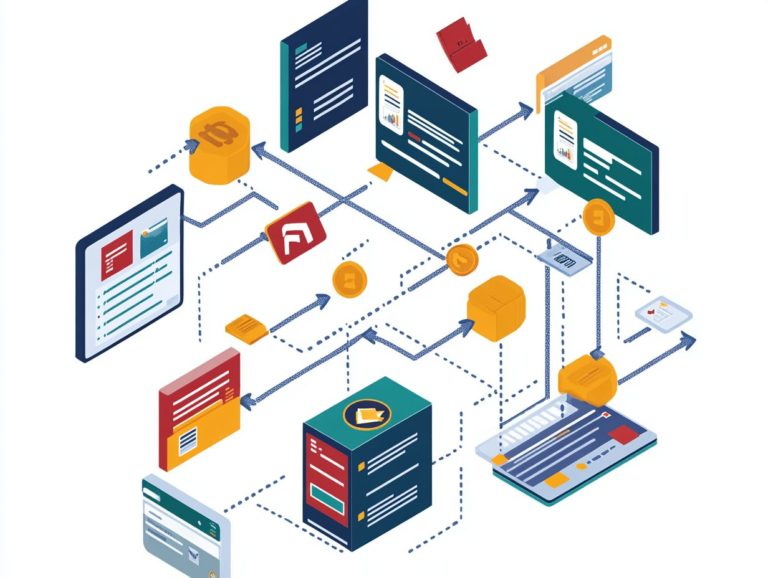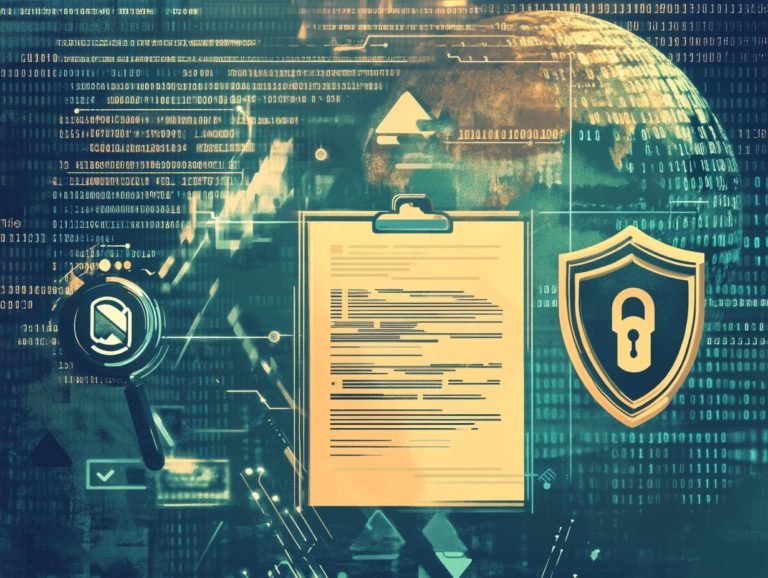5 common compliance mistakes to avoid
In today s fast-paced business environment, maintaining compliance with regulations is more than just a checkbox; it’s essential for your long-term success.
However, many companies stumble into common pitfalls that threaten their compliance status. This article delves into five frequent mistakes, ranging from overlooking regulations to inadequate employee training, along with the potential repercussions of these oversights.
You will also learn why compliance is so important, the key components of a robust compliance plan, and the tools that can help your business stay ahead of the curve. Uncover how to protect your organization and ensure seamless operations.
Contents
- Key Takeaways:
- 1. Not Staying Up-to-Date with Regulations
- 2. Not Conducting Regular Risk Assessments
- 3. Not Having a Compliance Plan in Place
- 4. Lack of Employee Training and Awareness
- 5. Not Having a System for Monitoring and Reporting Compliance
- Why Is Compliance Important for Businesses?
- Frequently Asked Questions
- What are some common compliance mistakes that businesses make?
- Why is it important to avoid compliance mistakes?
- How can a business stay up to date with regulations?
- What should be included in compliance documentation?
- What is the role of employees in compliance?
- How can a business ensure vendor compliance?
Key Takeaways:

- Stay current with regulations to avoid penalties.
- Conduct regular risk assessments to identify compliance issues.
- Develop a solid compliance plan to maintain stakeholder trust.
1. Not Staying Up-to-Date with Regulations
In today s swiftly changing regulatory landscape, it’s crucial for you to stay informed about regulations like the General Data Protection Regulation (GDPR), California Consumer Privacy Act (CCPA), and Health Insurance Portability and Accountability Act (HIPAA). Failing to do so can pose significant risks, especially for organizations in healthcare and financial services, where compliance isn’t just a checkbox it’s essential for safeguarding sensitive data and maintaining operational integrity.
Keeping yourself updated gives you the power to implement proactive measures, significantly reducing the chances of costly fines and reputational harm. For example, the GDPR underscores the importance of data protection by design. As a Chief Information Officer, you should weave privacy considerations into your technology development processes.
The CCPA demands transparency about how you use consumer data, pushing financial service providers to revisit their data-sharing policies to build consumer trust.
In the healthcare sector, adhering to HIPAA involves robust security protocols. You can utilize encryption and regular staff training to protect patient information effectively.
Actively engaging with this regulatory environment can be your shield against compliance issues and foster a culture of compliance that not only meets legal requirements but also enhances customer loyalty and ensures the sustainability of your business.
2. Not Conducting Regular Risk Assessments
Regular risk assessments are an essential part of your compliance strategy. They enable you to identify vulnerabilities and implement necessary measures for effective risk management and internal compliance.
By systematically evaluating potential risks, you can prioritize your compliance initiatives and allocate resources more efficiently. This proactive approach not only protects you against regulatory breaches but also fosters a culture of accountability within your organization.
The significance of auditing processes cannot be overstated; these evaluations ensure that your compliance measures are properly implemented and functioning as intended.
By embracing a cycle of continuous improvement, you ll be able to adapt to evolving regulations, enhancing your overall compliance efforts while building greater trust with stakeholders across various sectors.
3. Not Having a Compliance Plan in Place
A well-structured compliance plan is essential for you to navigate the intricate landscape of regulatory requirements. It provides a clear roadmap for risk management and ensures all necessary documentation is in place to demonstrate your adherence.
This comprehensive framework not only mitigates the risks associated with non-compliance but also fosters a culture of accountability and transparency within your organization.
By integrating key elements like training programs, regular auditing, and continuous monitoring, your compliance plan evolves into a vital component of your overall strategy. This synergy enhances your organization s ability to respond swiftly to regulatory changes and promotes consistent adherence to standards.
With well-documented processes and guidelines, communication flows more smoothly, ensuring that all employees are aligned with your commitments to legal and ethical obligations. Ultimately, this approach supports long-term success for your organization.
4. Lack of Employee Training and Awareness

Without proper training, your employees may struggle to understand compliance regulations. This lack of awareness can lead to serious risks for your organization.
To reduce these risks, prioritize training programs that enhance employees’ understanding of compliance guidelines and relevant policies. Offer comprehensive onboarding sessions, regular refreshers, and specialized workshops to keep pace with evolving regulations.
Fostering a strong IT governance framework is crucial. It ensures that technology is used effectively to monitor and manage compliance risks.
Consistent awareness initiatives, such as seminars and interactive learning modules, empower your staff to recognize potential issues early, strengthening your organization s ability to navigate compliance challenges.
5. Not Having a System for Monitoring and Reporting Compliance
Implementing a robust system for monitoring and reporting compliance is essential. It confirms adherence to regulations and assesses the effectiveness of your compliance strategy.
Advanced technologies, like automated data collection tools and cloud-based reporting systems, enhance this process. These systems streamline information gathering while keeping your data secure and compliant with privacy laws.
Integrating sophisticated analytics provides deeper insights into your operations. This helps identify potential risks before they escalate. Emphasizing data privacy during monitoring builds trust with stakeholders and reduces legal risks.
Why Is Compliance Important for Businesses?
Is your business prioritizing compliance? It should be at the forefront of your strategy, regardless of your industry, whether in healthcare or financial services.
Compliance isn t just about ticking boxes; it s about building trust with customers and protecting your organization from legal and financial pitfalls.
Take healthcare, for instance. Strict adherence to HIPAA guidelines rules that protect patient information safeguards data and establishes a reputation for responsibility and integrity.
In financial services, following regulations like the Dodd-Frank Act helps you mitigate risks associated with malpractice, boosting customer confidence in your institution s stability.
Compliance is crucial for your business’s success. Compliant organizations navigate challenges more effectively and adapt to changing market conditions.
By prioritizing compliance, you strengthen your risk management strategies, cultivate customer loyalty, and enhance your market position.
What Are the Consequences of Non-Compliance?
The consequences of non-compliance can be severe. They lead to hefty financial penalties, legal entanglements, and damage to your company’s reputation.
Consider a technology firm that faced a staggering $5 million fine for failing to follow data protection regulations. This misstep eroded stakeholder trust, creating a ripple effect. It didn t just mean immediate financial loss; it led clients to reconsider partnerships, impacting sales and long-term contracts.
In another case, a manufacturing company faced penalties for environmental violations, triggering a public relations crisis that damaged its brand image. Stakeholders, including investors and customers, began questioning the company s commitment to ethical practices, hindering its growth and market position.
These examples starkly illustrate how non-compliance can have broader implications, affecting every aspect of your organization.
How Can Businesses Ensure Compliance?

Start ensuring compliance today by adopting a proactive approach that includes a comprehensive compliance strategy, regular employee training, and strong monitoring systems designed to track regulatory requirements and adherence.
Beyond these foundational elements, it s essential to cultivate a culture of employee engagement. Ensure that everyone understands their role in maintaining compliance. When team members are encouraged to communicate openly about compliance issues, it enhances vigilance and helps identify potential risks.
Leveraging advanced technology can streamline your compliance processes, making it easier to stay updated on evolving regulations. Regularly reviewing compliance policies keeps them relevant and effective, ensuring your organization can swiftly adapt to the dynamic regulatory landscape and minimize exposure to risks.
What Are the Key Elements of a Compliance Plan?
A successful compliance plan includes several key elements, such as strong risk management protocols, thorough documentation, and a clear structure for reporting and monitoring compliance activities.
These components work together harmoniously and give you the power to identify potential compliance risks and tackle them proactively. With effective risk management protocols, you can systematically analyze and mitigate risks tied to various operations.
Comprehensive documentation serves as a solid record of policies, procedures, and compliance measures, ensuring nothing slips through the cracks. Establishing a well-defined structure for reporting and monitoring fosters accountability and clarifies each employee’s role in upholding compliance.
This interconnected framework not only bolsters individual initiatives within the plan but also cultivates an organization-wide culture of compliance, promoting transparency and trust throughout.
What Are Some Tools and Resources Available for Compliance?
You have a wealth of tools and resources at your disposal to help maintain compliance, including cutting-edge software that helps track and manage compliance activities. These solutions streamline your auditing processes and enhance data privacy measures.
These tools often come equipped with advanced analytics capabilities, enabling you to identify potential compliance risks before they escalate. For example, compliance management systems can automate the tracking of regulatory changes, ensuring you remain up-to-date with the latest requirements.
Platforms designed for employee training in compliance practices foster a culture of accountability and awareness within your organization.
By integrating comprehensive reporting functions and real-time monitoring features, these resources not only support your regulatory adherence but also empower you to make informed decisions, ultimately enhancing both operational efficiency and trust with your stakeholders.
How Can Businesses Stay Ahead of Changing Regulations?
To stay ahead of changing regulations, you must adopt a dynamic compliance strategy that fosters continuous improvement and adaptability to new legal requirements and industry standards.
This means establishing a strong system for monitoring legislative changes, which includes regular reviews of relevant laws and updates from regulatory bodies.
Engaging with industry associations can offer valuable insights into upcoming shifts, while leveraging technology and compliance software can streamline your tracking process.
By fostering a culture of learning within your organization, you enhance awareness and preparedness among your employees.
When you prioritize proactive approaches, you not only remain compliant, but you also position your organization to seize opportunities that may arise from emerging regulations, ultimately driving efficiency and innovation.
Frequently Asked Questions

What are some common compliance mistakes that businesses make?
Common mistakes include failing to stay updated on regulations, inadequate documentation of compliance efforts, not training employees on compliance procedures, overlooking vendor compliance, and neglecting to conduct regular compliance audits. To improve your processes, consider implementing 5 ways to ensure your compliance efforts are effective.
Evaluate your compliance strategies today or seek assistance to strengthen your approach!
Why is it important to avoid compliance mistakes?
Avoiding compliance mistakes is crucial for businesses. Not following rules can lead to legal penalties, damage to reputation, loss of customers, and financial losses. To better understand this, check out the article on 5 compliance myths debunked.
Maintaining ethical standards is essential for your business s success and helps protect sensitive information.
How can a business stay up to date with regulations?
Regularly review and assess all relevant laws and regulations. Subscribe to industry newsletters and alerts, and consult with legal experts if needed.
What should be included in compliance documentation?
Compliance documentation includes records that show how a business follows the rules. These records can consist of policies, procedures, training materials, audit reports, and risk assessments.
What is the role of employees in compliance?
Employees are key to compliance. They need training on relevant policies and should be encouraged to report any compliance issues.
How can a business ensure vendor compliance?
Carefully vet and select vendors. Clearly communicate compliance expectations and conduct regular audits.
Always include compliance clauses in vendor contracts to ensure everyone is on the same page.






